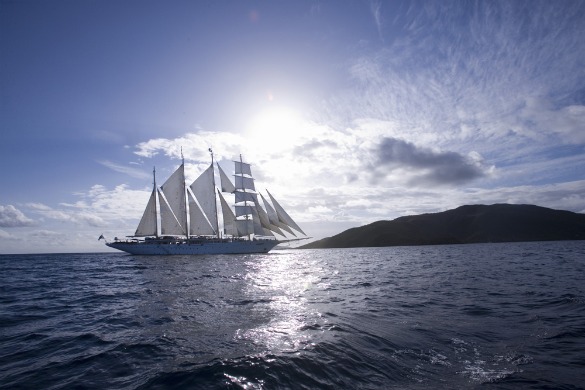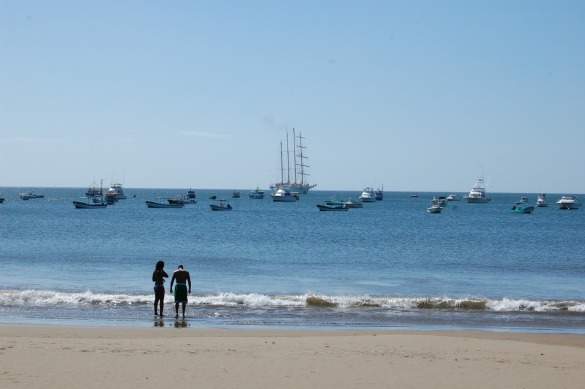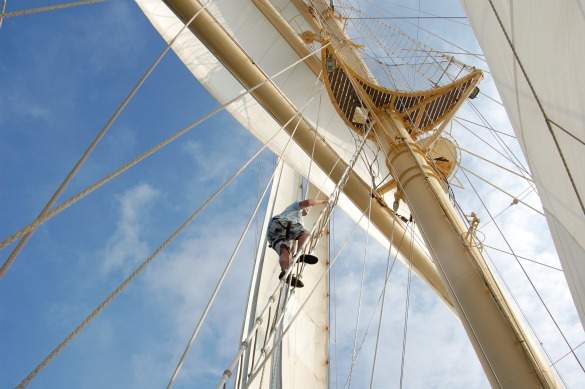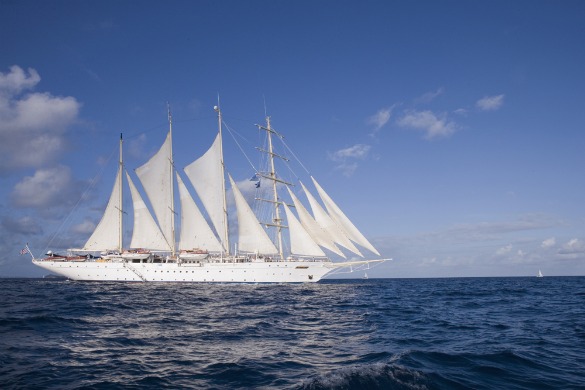Independent travelers often turn their noses up at the idea of cruising. Some don’t see any kind of packaged travel as “real” travel, while others don’t like the idea of only passing through each port, preferring instead to spend several days in any place they go.
But I think “independent travel” can come in many forms, that it is possible to have a meaningful experience even on a tour, that you can get a (very small) glimpse into life in a place in a short amount of time, and that taking the occasional “vacation” with the sole intention of relaxing in warm weather doesn’t take away your indie travel street cred.
For the independent traveler who agrees, and who wants to enjoy some of the benefits of a cruise (like not worrying about the logistics and seeing multiple places on one easy, relaxing trip) without succumbing to the mass tourism pitfalls associated with mega-cruises (over-commercialized ports and annoying crowds), a small-ship cruise is an excellent compromise.
Cruises on smaller ships – those that hold anywhere from 100-500 people – tend to be more intimate and relaxed, and often make stops at smaller, less-touristed ports, which can be a big draw for the more independent-minded traveler. I recently cruised the Pacific Coast of Costa Rica and Nicaragua on the Star Clippers‘ Star Flyer ship, and found all of these things to be true. But that doesn’t mean a small ship is without its faults. Before you book, here are a few pros and cons to consider.
Pro – A small ship is…well…smaller
On a 170-passenger ship like the Star Flyer (which is a mere 360 feet long by 50 feet wide), you can stand on one side of the deck and have a conversation (albeit a loud one) with someone on the other side. You can walk from any point on the ship to your cabin in under two minutes. There’s no getting lost, no trekking back and forth among decks or waiting in long lines to get on and off the ship. A small ship just feels more manageable and is easier to navigate around.
Con – A small ship lacks space
On a small ship, every inch is precious space and there may not be enough room for amenities found on larger ships. For example, there is no fitness center on the Star Flyer (instead a morning fitness class is held on deck each day) and the two small pools are only large enough to comfortably accommodate a few people at a time. There’s only one indoor/outdoor bar, one restaurant, and no casinos or theatres. On a day at sea, that space can start to feel a little too small for some people.
Pro – A small ship cruise is more intimate
On the Star Flyer, there were 72 crew members to 170 passengers. Not only was the service exceptional, it was also more personal. You learn the names of the crew (and they yours) and begin to make friends with other passengers, as you see the same small group of people day in and day out. Cruising on a small ship feels less like you’re on a cruise, and more like you’re are sailing around on a friend’s yacht.
Con – Sometimes it might feel a little too intimate
On a small ship cruise, there isn’t the same level of anonymity afforded on a larger ship. One night, my husband and I stayed up until nearly midnight chatting with some new friends in the bar, drinking Prosecco. The next day at lunch, the same bartender who served us the night before noticed my tired look and asked with a wink, “Something to drink…maybe some Prosecco?” We laughed, but it illustrates the fact that on a small ship, here’s no hiding in the crowd. And if you find you don’t get along well with a certain person, you can’t avoid them; in fact, it’s guaranteed that you’ll run into them at least a few times per day. On a ship with hundreds more people, it’s that much easier to blend in.
Pro – You actually feel like you are on a ship
On a small ship, you can see the water no matter where you are on the boat. You can hear the water, and you can certainly feel its effects as the boat rocks gently back and forth. On a sailing vessel like the Star Flyer, you’ll also see plenty rigging and ropes, you can climb up in to the crow’s nest or relax in the widow’s nest on the bowsprint, and there are even opportunities to help hoist the sails. There were lessons in knot-tying and one day we came out on deck to see a sail being repaired with an industrial sewing machine. There’s no escaping the fact that you are on a real working ship, which many people prefer to the “floating hotel” experience of a large ship.
Con – In rough seas, you really feel like you are on a ship
The gentle rocking of the ship can become a forceful swaying in rough seas, and if you’re prone to seasickness it can be very unpleasant. On most days, I was only vaguely aware of the swaying, but on one day, particularly bad swells left our boat – and the contents of my stomach – careening from side to side. At that point, there is nothing you can do but pop some dramamine and hold on as the ocean jostles the boat back and forth. If you have a more sensitive stomach, a larger and more stable ship might be a better option.
Pro – Small ships can go where big ships can’t
One our Star Clipper cruise, we visited the small beach towns of San Juan del Sur, Nicaragua and Playa del Coco, Costa Rica, along with a private island, an empty beach, and a national park. Ours was always the biggest (and in some cases) only boat of any kind in the area. Small ships can go where big ships simply can’t – either because the water is too shallow, because the area isn’t built up for mass tourism, or because the infrastructure isn’t there. We were able to anchor offshore and tender onto the beach on zodiacs, hopping off into knee-deep water. On a large ship, visiting those places would not have been possible.
Con – Small ships are more affected by weather
Because they move a bit more and tend to go to smaller ports that require a tender to shore, a small ship can be more affected by strong weather and waves. On the fifth day of our cruise, it was deemed too dangerous, due to strong swells, for passengers to climb down the stairs and board the tenders. So our day in port was scrapped and instead we set sail for the next destination, enjoying another day at sea. Though large ships can be rerouted too, if you aren’t comfortable with the idea that you could miss out on a highly anticipated port, you may find a large ship provides more consistency.
Pro – Small ships don’t offer the endless choices a large ship does
It’s easy to overindulge on a mega-cruise. With all the activities, shows, nightlife, and dining choices, it’s easy to come back from your vacation more exhausted – not too mention a few pounds heavier – than when you left. Sure, you could restrain yourself from hitting the all-night buffet at 11pm after too many drinks, but it’s a difficult thing to do. On a small ship cruise, your willpower – or lack thereof – is taken out of the equation. Meals are served at set times, and though you could hit the morning or lunch buffet too hard, at least you’re cut off from eating for a few hours each day. You also have fewer choices to overwhelm you when it comes to activity; at each port there are two-three shore excursions to choose from, and at night, there’s only one option for entertainment. For some the smaller number of options means more time to truly relax.
Con – You may feel too limited by the options available
If you’re used to having lots to choose from on a large ship, you may find the options on a small ship too limiting. If none of the shore excursions on a particular day are of interest, you’re left to do without. And if you happen to miss one of the meal times, or if you don’t like what is offered one day, there’s nothing to be done and no other alternative. If the options appeal to you, there’s no need for more…but on a day when they don’t, you may find yourself frustrated.
Pro – Small ships can offer activities and experiences a large ship can’t
On the Star Flyer, guests are invited to not only help hoist the sales, but to climb up into the crow’s nest on the top of the mast as well. Guests are harnessed in and climb a slanted rope-and-metal ladder up for a birds’-eye view of the ship and the surrounding ocean. Later, they can listen to the Captain’s stories from the sea in an intimate atmosphere. In port, small groups get taken out on zodiacs to scuba, snorkel, waterski, kayak, or search for dolphins and whales, which are often spotted near the ship. The smaller number of passengers means less demand for these activities, many of which just can’t be done with a larger group.
Con – You may find yourself bored on a small ship
Mega-cruise ships ensure that you couldn’t possibly grow tired of all the activities on board. With rock-climbing, multiple pools and restaurants, kids club, casinos, and Broadway-style shows, there’s always something to do on a big cruise. If you prefer a greater variety of activities and entertainment, you may find the routine of a small ship too monotonous.
Pro – Small ships are more eco-friendly
On the Star Flyer, the crew attempts to use the sails for power as much as possible, often running entirely on wind or supplementing with a smaller amount of engine power. They’ve also upgraded to a high-grade marine gas oil, which contains 45 times less sulphur than the current environmental standard. The ship has also installed a new water-treatment system that filters all water to a drinkable level of purity before releasing it into the ocean. And since the ship calls on smaller ports and ferries passengers ashore in tenders, rather than building docks to accommodate them, there is less impact on the local environment.
Pro -Small ships can be more luxurious
On the Star Flyer, 72 crew members attend to just 170 passengers and all but 6 cabins have sea views. Guests are welcomed onboard with cocktails and each cabin is serviced twice per day. With a higher staff to passenger ratio, the service on a small ship can be superior to that on a mega-ship. Add the more intimate nature of the cruise, and the unique experiences offered, and a smaller cruise ship can feel more exclusive than its larger counterparts that cater to the masses.
Con – Small ships are more expensive
Of course, with that luxury and exclusivity, comes a higher price. Most small ships cruises cost much more than comparable cruises (in terms of destination and cruise length) on larger ships, which rely on a higher number of bookings to offset a lower price. For example, the Star Clippers 7 night Costa Rica and Nicaragua cruises start at $1875 per person, compare to the mega-ships, which can cost $500 per person (and sometimes less).
Learn more about cruising:
- 7 Things to Know Before You Book Your First or Next Cruise
- 10 Reasons to Take a Repositioning Cruise
Disclosure: I was a guest of Star Clippers, but my opinions are my own.







